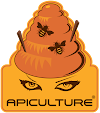Signs of a laying worker:
- Brood Pattern:Laying workers lay eggs that lack the queen's egg recognition pheromone, meaning that other workers may remove the eggs. This results in a spotty brood pattern, in which empty cells are scattered heavily through capped brood.
- Number of Eggs per Cell: The beekeeper looks at the honeycomb cells to see how many eggs are laid in each one. Queen bees will usually lay only a single egg to a cell, but laying workers will lay multiple eggs per cell. Multiple eggs per cell are not an absolute sign of a laying worker because when a newly mated queen begins laying, she may lay more than one egg per cell.
- Egg Position:Egg position in the cell is a good indicator of a laying worker. A Queen bee's abdomen is noticeably longer than a worker, allowing a queen to lay an egg at the bottom of the cell. A Queen bee will usually lay an egg centered in the cell. Workers cannot reach the bottom of normal depth cells, and will lay eggs on the sides of the cell or off center.
- Drone Brood in Worker Cells: Another good indicator is drone brood in worker sized cells. Drones are raised in larger cells than workers. Drone cells are recognizable by their larger size, and when capped Drone cells are capped with blunt pointed cappings. Drones in worker cells are a sure sign of a failing queen or laying worker.
Double click on picture to see eggs.






No comments:
Post a Comment